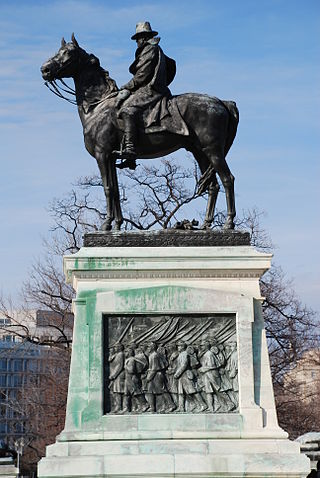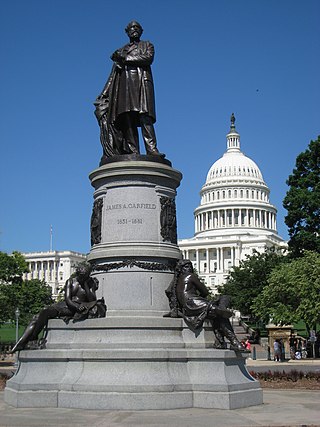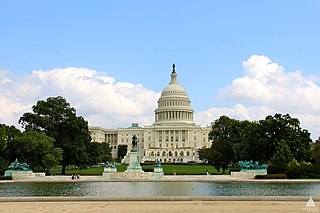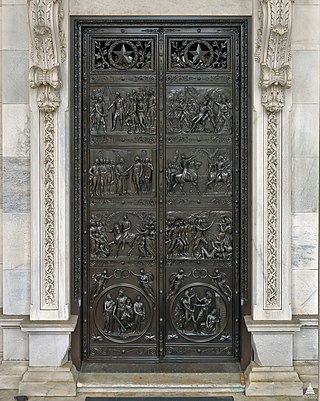| Statue of Ulysses S. Grant | |
|---|---|
 The statue in 2011 | |
| Subject | Ulysses S. Grant |
| Location | Washington, D.C., U.S. |
A 1899 marble sculpture of Ulysses S. Grant by Franklin Simmons is installed in the United States Capitol's rotunda, in Washington, D.C. [1]
| Statue of Ulysses S. Grant | |
|---|---|
 The statue in 2011 | |
| Subject | Ulysses S. Grant |
| Location | Washington, D.C., U.S. |
A 1899 marble sculpture of Ulysses S. Grant by Franklin Simmons is installed in the United States Capitol's rotunda, in Washington, D.C. [1]

The Ulysses S. Grant Memorial is a presidential memorial in Washington, D.C., honoring American Civil War general and 18th president of the United States, Ulysses S. Grant. It sits at the base of Capitol Hill, below the west front of the United States Capitol. Its central sculpture of Grant on horseback faces west, overlooking the Capitol Reflecting Pool and facing toward the Lincoln Memorial, which honors Grant's wartime president, Abraham Lincoln. Grant's statue is raised on a pedestal decorated with bronze reliefs of the infantry; flanking pedestals hold statues of protective lions and bronze representations of the Union cavalry and artillery. The whole is connected with marble covered platforms, balustrades, and stairs. The Grant and Lincoln memorials define the eastern and western ends, respectively, of the National Mall.

The United States Capitol Complex is a group of twenty buildings, grounds, and facilities in Washington, D.C., that are used by the United States Congress, and federal courts. The buildings and grounds within the complex are managed and supervised by the Architect of the Capitol.

Henry Merwin Shrady was an American sculptor, best known for the Ulysses S. Grant Memorial on the west front of the United States Capitol in Washington, D.C.

The James A. Garfield Monument stands on the grounds of the United States Capitol in Garfield Circle, a traffic circle at First Street and Maryland Avenue SW in Washington, D.C. It is a memorial to U.S. President James A. Garfield, who was elected in 1880 and assassinated in 1881 after serving only four months of his term. The perpetrator was an attorney and disgruntled office-seeker named Charles J. Guiteau. Garfield lived for several weeks after the shooting, but eventually succumbed to his injuries. The monument is part of a three-part sculptural group near the Capitol Reflecting Pool, including the Peace Monument and the Ulysses S. Grant Memorial in Union Square. The monument is also a contributing property to the National Mall and L'Enfant Plan, both of which are listed on the National Register of Historic Places and the District of Columbia Inventory of Historic Sites. The bronze statue rests on a granite pedestal that features three sculptures, each one representing a time period in Garfield's life.

The Peace Monument, also known as the Navy Monument, Naval Monument or Navy-Peace Monument, stands on the western edge of the United States Capitol Complex in Washington, D.C. It is in the middle of Peace Circle, where First Street and Pennsylvania Avenue NW intersect. The surrounding area is Union Square, which the monument shares with the Ulysses S. Grant Memorial, James A. Garfield Monument, and the Capitol Reflecting Pool. The front of the monument faces west towards the National Mall while the east side faces the United States Capitol.

The United States Capitol building features a central rotunda below the Capitol dome. Built between 1818 and 1824, the rotunda has been described as the Capitol's "symbolic and physical heart".

Franklin Bachelder Simmons was a prominent American sculptor of the nineteenth century. Three of his statues are in the National Statuary Hall Collection, three of his busts are in the United States Senate Vice Presidential Bust Collection, and his statue of Ulysses S. Grant is in the United States Capitol Rotunda.

The Capitol Reflecting Pool is a reflecting pool in Washington, D.C., United States. It lies to the west of the United States Capitol and is the westernmost element of the Capitol grounds. The Capitol Dome and the Ulysses S. Grant Memorial are reflected in its waters.

The George Gordon Meade Memorial, also known as the Meade Memorial or Major General George Gordon Meade, is a public artwork in Washington, D.C. honoring George Meade, a career military officer from Pennsylvania who is best known for defeating General Robert E. Lee at the Battle of Gettysburg. The monument is sited on the 300 block of Pennsylvania Avenue NW in front of the E. Barrett Prettyman United States Courthouse. It was originally located at Union Square, but was removed and placed in storage for fourteen years before being installed at its current location. The statue was sculpted by Charles Grafly, an educator and founder of the National Sculpture Society, and was a gift from the state of Pennsylvania. Prominent attendees at the dedication ceremony in 1927 included President Calvin Coolidge, Governor John Stuchell Fisher, Secretary of the Treasury Andrew W. Mellon, and Senator Simeon D. Fess.

The Revolutionary War Door is an artwork by American sculptor Thomas Crawford, located on the United States Capitol House of Representatives wing east front in Washington, D.C., United States. This sculptured door was surveyed in 1993 as part of the Smithsonian's Save Outdoor Sculpture! program.

The statue of John Aaron Rawlins, a United States Army general who served during the Civil War and later as Secretary of War, is a focal point of Rawlins Park, a small public park in Washington, D.C.'s Foggy Bottom neighborhood. It was installed in 1874, but relocated several times between 1880 and 1931. The statue was sculpted by French-American artist Joseph A. Bailly, whose best known work is the statue of George Washington in front of Independence Hall in Philadelphia.

Union Square is an 11-acre public plaza at the foot of Capitol Hill in Washington, D.C., United States. It encompasses the Ulysses S. Grant Memorial (1924) and the 6-acre Capitol Reflecting Pool (1971) and is just west of the United States Capitol building. Views differ as to whether the Square is just east of the National Mall or is itself the eastern end.

Ethan Allen is a marble sculpture of Ethan Allen by Larkin Goldsmith Mead.

Ronald Reagan is a bronze sculpture depicting the American politician of the same name by Chas Fagan, installed at the United States Capitol's rotunda, in Washington, D.C., as part of the National Statuary Hall Collection. The statue was donated by the U.S. state of California in 2009, and replaced one depicting Thomas Starr King, which the state had gifted in 1931. The statue stands on top of fragments from the Berlin Wall.

Andrew Jackson is a 1928 bronze sculpture of Andrew Jackson by Belle Kinney Scholz and Leopold Scholz, installed in the United States Capitol, in Washington D.C., as part of the National Statuary Hall Collection. It is one of two statues donated by the state of Tennessee. The statue was accepted into the collection by Senator Kenneth McKellar on April 16, 1928.
Francis Harrison Pierpont is a 1910 marble sculpture of Francis Harrison Pierpont by Franklin Simmons installed in the United States Capitol, in Washington, D.C., as part of the National Statuary Hall Collection. It is one of two statues donated by the state of West Virginia. The sculpture was unveiled by the Hon. Thomas Condit Miller, on April 27, 1937.

Jonathan Trumbull is an 1872 marble sculpture of Jonathan Trumbull by Chauncey Ives, installed in the United States Capitol, in Washington, D.C., as part of the National Statuary Hall Collection. It is one of two statues donated by the state of Connecticut. The sculpture was unveiled by Senator William Alfred Buckingham of Connecticut on March 8, 1872.

The Statue of Abraham Lincoln by Vinnie Ream is installed in the United States Capitol's rotunda, in Washington, D.C. The statue was completed in 1871.

A 1976 marble sculpture of James Madison by Walker Hancock is installed in the James Madison Memorial Building, in Washington, D.C., United States.

The George Washington and the Revolutionary War Door (1855–1868) is pair of a bronze sculptured doors to the Senate wing of the United States Capitol in Washington, D.C., United States. American sculptor Thomas Crawford designed and modeled the doors in the mid-1850s, but died prior to their completion. American sculptor William H. Rinehart completed the doors based on Crawford's designs.